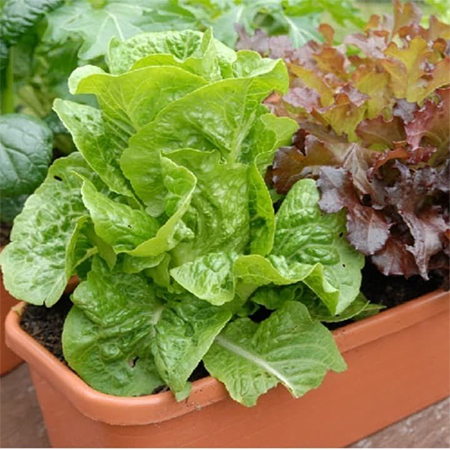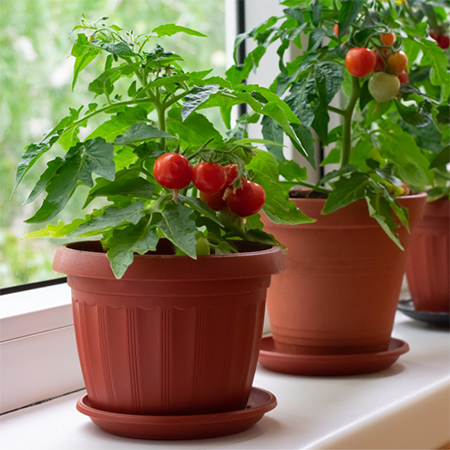Growing Food Without a Garden
Even if you have a tiny or no outdoor space, there are still ways to grow food!
06/09/2022
Growing your food is an excellent way to go organic and reduce the amount of money you spend on groceries. But if you don't have a garden, or it's just not an option, that doesn't mean you can't grow your vegetables. Even if you have a tiny or no outdoor space, there are still ways to grow food! The possibilities are endless, from containers on a balcony to microgreens that can be grown on a windowsill in the kitchen.
You can reap the benefits of growing your food when you do it yourself. It makes you feel closer to nature, helps you learn the seasons, and can be just plain fun. Grow your food for various reasons, including money savings and healthier food. Do not despair if you are short on space to grow food; you can still grow your edibles.
Methods to Grow Food Without a Garden
When planting a garden, it is important to consider the amount of space you have available. It may seem impossible to grow an edible garden if you have a small garden or none. With some creativity and resourcefulness, there are ways to grow food without having a big garden or even a balcony or patio.
Use Containers
You can grow plants in containers of all sizes. Large tubs or barrels work well for tomatoes, peppers, and eggplant. You can also use smaller pots to grow herbs, greens, and strawberries. Containers are available at garden centres or your local Builders store in various colours and materials: wood, plastic, ceramic, and metal.
Upside: You don't need much space to start a container garden. You can grow food anywhere there's sun, on decks or patios, rooftops, balconies, windowsills, and even on concrete sidewalks without grass.
Downside: Plants grown in containers need more watering than those in the ground because they have less soil to absorb water from raindrops or irrigation systems.
Window Boxes
A window box allows you to grow herbs and vegetables in a small space. The area inside the box should be filled with potting mix and then planted with seeds or seedlings. They can be made of wood, metal, or plastic, and you can be creative with their design. A good window box will sit on top of the windowsill, so it doesn't need extra support from outside.
Some people choose to build the box themselves, while others buy pre-made ones. Building your own will require sturdy materials so it won't fall off the windowsill.
Raised Beds
If you live in an apartment and have access to just a small patch of grass or dirt behind the building, consider building a raised bed garden there. The best way to do this is to use pallets or wooden crates as walls for your raised bed garden. Fill these walls with potting soil and plant directly into them so that nothing goes to waste; old newspapers make excellent weed barriers!
Use the area underneath your raised bed as a compost pile. A compost pile is a great way to grow healthy vegetables, even in small spaces.
Rooftop Gardens
Consider planting a garden if you have a rooftop or balcony with enough sun. It's the perfect place to escape the city noise and relax with nature, and it can save money on groceries too. You'll need special equipment like a greenhouse, but once it's set up, this type of garden will save space and water for you and the planet!
These gardens take advantage of roof space that would otherwise go unused by growing plants on top of the building. Rooftop gardens allow residents to grow fresh veggies without worrying about soil quality or weather conditions affecting their harvests.
Community gardens are a wonderful way to meet new people and to establish an unused area into a place to grow your own food.
Community Gardens
If you are totally out of space, even a rooftop garden, try finding one nearby where you can share space with others who have similar goals. Community gardens are popping up everywhere as people realise the benefits of sharing a garden space. If you don't have a community garden in your area, get together with neighbours and like-minded gardeners to see if you can find an area that would be suitable for a community garden.
Community gardens are a great way to meet other people interested in gardening and can help you learn more about it. They're also a good way to get your feet wet if you haven't gardened before or want to try something new.
Hang Plants Up High
Growing plants doesn't require them to be in the ground. Try hanging them up high with some string and a bucket or pot underneath. You can use anything you want as a container; an old mason jar or plastic container will do just fine. Ensure the plant is placed near a sunny window; always water it when needed. This method is great for growing strawberries, pineapples, and many other plants!
You can also try planting some herbs like basil or mint. These are easy to grow and will look great hanging from the ceiling. It will be easy to cook or flavour your drinks with fresh herbs!
Try Microgreens
Microgreens are small seedlings that will grow quickly in your home. They're perfect for people like me who don't have room for full-grown plants but still want to enjoy fresh greens daily! Microgreens are tiny versions of common vegetables like lettuce and spinach grown in small containers and eaten before they have had time to develop into full-sized plants.
They're very popular among farmers because they take little time or effort but give big results regarding harvest size and quality. You can grow microgreens indoors or outdoors, depending on your available space.
Use The Hydroponics
Hydroponics is the process of growing plants without soil. It's one of the most popular methods for growing vegetables, herbs, and other plants indoors.
To start using the hydroponics method, you'll need a suitable container with holes through which water can drain. Seedling and plant trays sit in the container and hold your seedlings/pants and nutrient solution (usually water with dissolved nutrients) to keep your plants happy while growing.
Once you have your bucket and trays, fill the bucket with water, put the trays in it, and add your seeds. The easiest way to do this is to use a seedling starter kit. This will give you everything you need to start, including some starter nutrient solution that comes pre-mixed and ready for use.
Final Words
You don't need to live on an urban plot of land to grow food. With the right containers, window boxes, or just rows of pots lining a balcony, you can grow herbs, vegetables, and flowers all year round. It doesn't require you to spend your weekends taking care of them.
These plants are low maintenance and can happily sit there while you're at work. Simply go outside at lunchtime and give them some water, sunshine, and a little love; before you know it, they'll fill your home with vibrant colours and the most delicious flavours.










